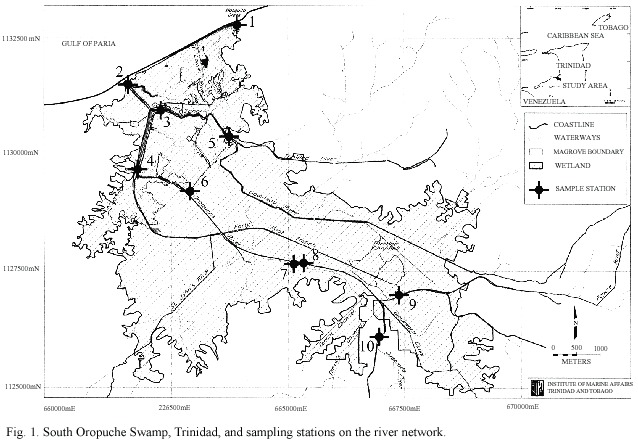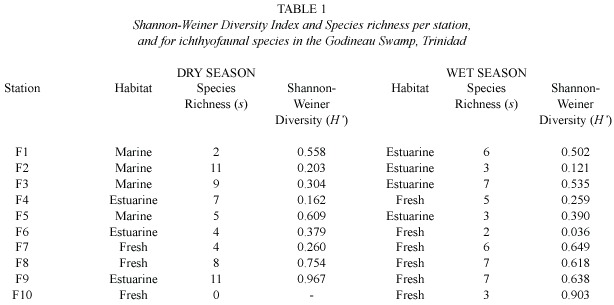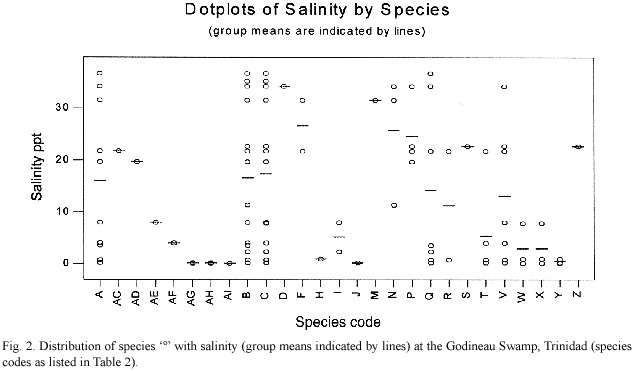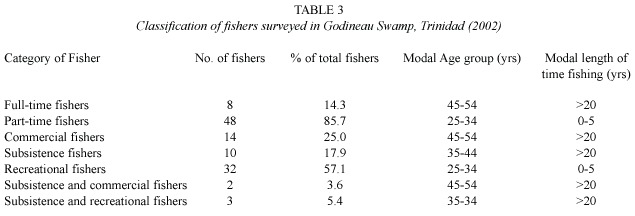Services on Demand
Journal
Article
Indicators
-
 Cited by SciELO
Cited by SciELO -
 Access statistics
Access statistics
Related links
-
 Similars in
SciELO
Similars in
SciELO  uBio
uBio
Share
Revista de Biología Tropical
On-line version ISSN 0034-7744Print version ISSN 0034-7744
Rev. biol. trop vol.53 suppl.1 San José May. 2005
The distribution and abundance of wetland ichthyofauna,and exploitation of the fisheries in the Godineau Swamp,Trinidad –Case study
Himawatee Ramsundar
Institute of Marine Affairs,P.O.BOX 3160,Carenage Post Office,Trinidad,West Indies.Fax:1(868)634-4433; hramsundar@ima.gov.tt
Received 15-I-2003. Corrected 27-X-2003. Accepted 29-III-2004.
Abstract:The Godineau (South Oropuche)Swamp (3171 ha)on the southwestern coast of Trinidad (10 º13- 15 N,61 º30-32 W)is heavily impacted by anthropogenic activities including fishing,oil exploration, drainage manipulation and wetland clearance.To reduce the negative effects of these activities and to manage the swamp more sustainably,more quantitative information is needed on the ecology of the wetland and the activities that occur within it.This study focuses on the distribution of the fish resources and exploited fisheries as a basis for more informed management directives. Sampling was conducted during 2002,in April-May (for dry season)and July-September (for wet season sampling).Ichthyofauna was sampled both day and night using trammel nets and a push seine.Fishing activities were assessed using a questionnaire and informal discussions with fishers.The wetland supports over 29 species of fish distributed over the freshwater,estuarine and saline zones (n=1454). Species distribution is seasonal,with evidence of the wetland being used as a spawning ground. Species richness and species diversity (Shannon-Weiner Index)for the wetland ranged over 2-11 and 0.162-0.967,respectively, in the dry season and 2-7 and 0.036-0.903,respectively,in the wet season.Communities inhabiting the saline and estuarine zones of the wetland were dominated by a single species,Hexanematichthys bonillai .Percent Similarity Indices were 41.8%for freshwater, 72.7%for estuarine and 79.8%for estuarine-saline communities. The commercial species accounted for 18%of total catch sampled and consisted of Centropomus undecimalis, Megalops atlanticus ,Hoplosternum littorale ,Hoplias malabaricus ,Ophioscion punctatissimus and Macrodon ancyclodon .Full-time and part-time fishers,including recreational fishers,accounted for 14.3%and 85.7%, respectively of all fishers surveyed (n=56).A conservative estimate of the revenue earned directly at point of sale for fish and shellfish,is approximately US$43 000 per annum.Fishing is important in the area.Management directives taking into account the ecology of the target organisms are needed to allow these fishing practices to be continued in a sustainable manner.
Key words:Wetland fisheries,wetland ichthyofauna,seasonal distribution,island fisheries,Caribbean fresh- water fisheries.
Coastal wetland ichthyofauna is typically a diverse assemblage of species important to inland and offshore fisheries (Rakocinski et al.2000).In the Caribbean,wetlands are also the focus for economic activity including fisheries, commerce, industry,tourism and housing (Clark 1992).In Trinidad,wetlands have historically been converted for other uses or allowed to degrade (Alleng 1997).Wetland degradation has been attributed to pollution, coastal development, fires, agriculture, dredging and drainage schemes,and unsustainable and destructive use of the wetland resources (James 1990).The ecology and assessment of these fisheries is usually less studied because of the small-scale nature of most of the fishing activities and limited resources with which to assess them (Berkes et al.2001).
The Godineau Swamp has been settled for over 100 years and has been subjected to oil exploration since the early 1900s (Anonymous 2001).The swamp has also been termed the granary of Trinidad (Itakura 1974)because of its capacity for rice production.Small crop farming and animal husbandry has been practiced within the last ten years and there have been eco-tourism activities in the last five years.Between 2002 and 2003,several drainage works,including sluice gates and levees have been upgraded and there are plans for the inclusion of further industrial development and residential settlements in and around the wet-land (Ministry of Planning,pers.comm.).
These competing uses have heightened interest in the management of the Godineau Swamp,further leading to an assessment of the wetland ecology.The present study is a component of this assessment,providing an inventory of the distribution and relative abundance of finfish species,as well as a description of resource use by local fishers.Baseline information provided from this and other related studies by the Institute of Marine Affairs (IMA) in 2002 are to be used to inform management directives for the wetland.
Materials and methods
Study Area
The Godineau Swamp is located on the west coast of the island of Trinidad at 10 º13- 15 N,61 º30-32 W (Alleng 1997) (Fig.1).The wetland is an estuarine system and includes a brackish coastal lagoon behind a sandbar with mangroves,tidal mudflats,freshwater and brackish-water marshes on the landward margins (James et al.1986).It is mixed estuarine wetland of approximately 3200 ha (IMA, unpublished),with mangrove fringes,elevated islands and extensive marshland dominated by Eleocharis spp.and C yperus spp.(Ramcharan et al.1982,James et al.1986,Alleng 1997). The outcroppings of higher ground are vegetated by swamp wood forest (Pterocarpus spp.)and sugar-cane.The wetland is drained by one major river system,the Oropuche River, with major tributaries including the Forty Foot Trench,the Cipero,St.Johns, Trinidad and Blackwater Rivers which merge into Godineau River and flow into the Gulf of Paria in the Caribbean Sea (Fig.1).
Ichthyofaunal survey
The wetland is tidally influenced and subject to salt water intrusion due to faulty drainage.For the purposes of this study,the waterways were categorized as freshwater (<5 ppt)-where there was minimal or no salt water influence-,estuarine -where there was mixing of saline and freshwater-(5-25 ppt),and saline -where conditions were predominantly marine- (>25 ppt)(Thurston and Gehrke 1992).
Ten sampling stations were selected (Table 1)in a stratified random manner.Stations were sampled once in the dry season during April to May and once in the wet season (In Trinidad, the dry season extends from December to May and the wet season from June to November) during July to September 2002.Fish were collected using a trammel net (6 cm stretched inner,30 cm stretched outer mesh,15 m width, 2 m depth)for channels over 1.5 m deep and a push seine (1 cm stretch,15 m wide,2 m depth)for shallower waterways (<1.5 m deep). Trammel nets were set for fishing between dusk into nightfall (6-10 P.M.)under conditions of dim moonlight for a soak time of three hours.Seine sampling was conducted during the day,where stations were sampled with a single drag.Temperature,dissolved oxygen, salinity and pH were measured using an automatic meter (YSI multiparameter sonde,XLM 1000)and bank vegetation was noted at each station immediately prior to sampling.
Organisms collected were sorted by species,weighed (±1 g),measured (±1 mm FL and TL)and sexed.Species were ranked as rare (<5 individuals),occasional (5-20),common (21-50)and abundant (>50 individuals) based on total numbers caught during sampling (Ramnarine 1997).Total counts were made of hydrated oocytes in gravid female Hexanematichthys bonillai by macroscopic examination to determine any relationship between fish length and number of eggs.
Fisheries survey
Fisheries related data were collected using key informants and from both formal and informal interviews with fishers using structured questionnaires.Information collected included type of fishing, species targeted, areas fished,gear used,estimated income, market distribution and management recommendations.Interviews were conducted over a consecutive five-day period in January 2003, inclusive of weekend to capture weekend recreational activities.Fishers were identified by driving through the study area over land and on the navigable waterways.
Data Analysis
Data analysis included the calculation of species richness (s =number of species)and relative abundance (p i )based on the number of individuals caught (p i =n i /N).Relative abundance plots for each habitat and Rank Abundance curves for the dry and wet seasons were plotted to illustrate trends in the species abundance.Diversity was estimated using the Shannon-Weiner diversity index. Communities were analysed by comparing community similarity during the wet and dry seasons using the Proportional Similarity (PS )Index where

and x i and y i are the proportions of i th species of the total number of fish caught per habitat in the dry and wet seasons respectively (Brower et al.1990).
Results
Fish distribution and abundance
The ichthyofaunal sampling collected 29 species distributed over the entire wetland (Fig.2).Relative abundances were similar in the dry and wet seasons,however,the number of fish caught in the wet season was less than half (42%)that in the dry season. Megalops atlanticus ,had the largest biomass but with only nine individuals as it was the largest species captured (30.6 cm FL,282 g to 81.5 cm FL,4100 g).A list of species and their abundance ranking following Ramnarine (1997)are given in Table 1.The most common species (highest relative abundances at any station)were Hexanematichthys bonillai, Centropomus undecimalis and H.herzbergii in the estuarine and saline areas,and Polycentrus schomburgkii ,Astyanax bimaculatus and H. bonillai in the freshwater areas (Table 2).H. herzbergii ,H.bonillai ,C.undecimalis and M. atlanticus were found distributed throughout the swamp in all habitats (freshwater,estuarine and saline).
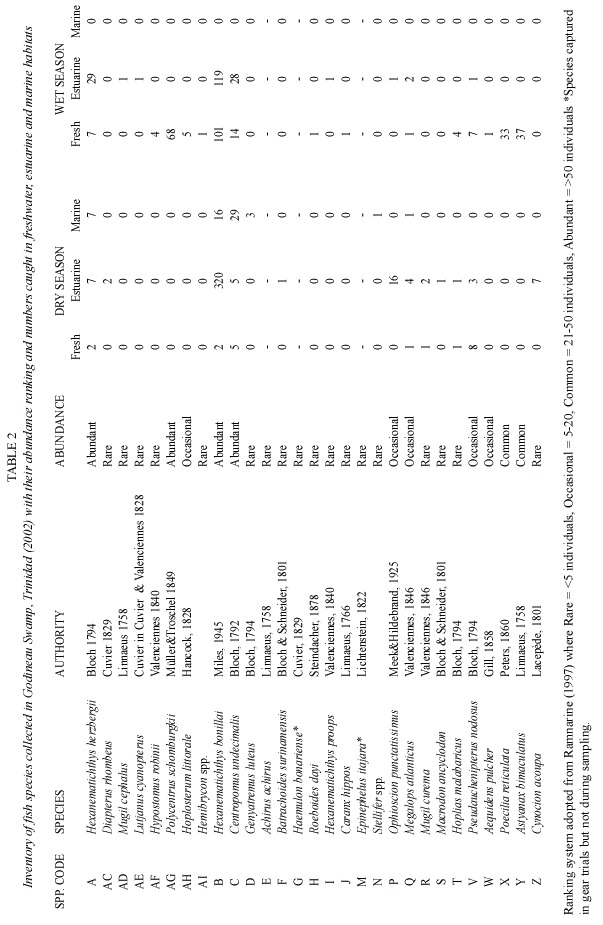
The Shannon-Weiner (H )diversity index for both wet and dry seasons (Table 2)were higher at the inland stations (F8,F9,and F10)in the freshwater to estuarine areas,and lower at the coastal stations (F1,F2 and F3) that were more exposed to semi-diurnal tidal influence.Relative abundance plots for the wet and dry season indicate that the ichthyofaunal population is best described by a geometric exponential plot (r2 =0.91 for dry season and 0.97 for wet season).The plots follow the dominance-pre-emptive model for distribution characterized by high dominance and low equitability of distribution of individuals among the species (Begon et al.1996)(Fig.3).In this model,each successive species occupies 50% (or more)of the niche space and has twice as many individuals as the species ranked just below it.Of the fish captured during sampling, 18%were commercial species (C.undecimalis, M.atlanticus ,Hoplosternum littorale ,Hoplias malabaricus ,Ophioscion punctatissimus and Macrodon ancyclodon ).
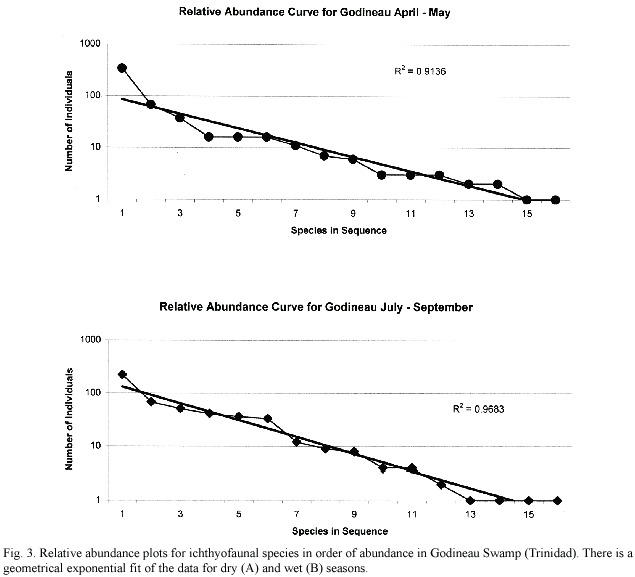
Sampling in the dry season resulted in a larger number of rare species (Table 1)than the wet season.Community similarity was calculated for each of the habitats over the dry and wet seasons using the Percent Similarity (PS) index.PS values were 42%for freshwater areas and 73%and 80%,respectively,for estuarine and saline communities.The freshwater communities exhibited the most change over the seasons.Fresh water areas of the wetland are found mainly inland where the waterways are small and carry less discharge.Some of these channels,such as station F10,contain little discharge during the dry season because of the complex hydrology and restrictions in the drainage.
Biological characteristics of two common species
The most common species in the wetland was the catfish H.bonillai (New Granada sea catfish),found in all three habitats with size range 18.0-29.7 cm FL (mean 23.2,SD=2.1cm FL),accounted for over 60%and 70%of the catch in the dry and wet seasons respectively, and approximately 67%of the total biomass. Populations were concentrated at the coastal areas near the Godineau River mouth (stations F2 and F4).Sampling indicated little difference in the numbers of males (502)to females (466). Most females collected during the dry season sampling at stations F2 and F4 were gravid with ripe gonads, as sampling coincided with a spawning period (May –June)for the species (Ramnarine (1997)found that spawning peaked during May-June and August-December).No relationship could be found between number of eggs and the females (n=22)weight (94-334g) or length (18.9-28.7cm FL),which is consistent with this species multiple batch spawning behaviour.Analysis of variance using a general linear model for the length and weight of H.bonillai were not significantly co-related with season,sex or habitat.The length-weight relationship calculated for the population was: y =2.7402 x -1.5395 for males (n =506)(r2 = 0.781)and y =2.9122 x -1.7408 for females (n =472)(r2 =0.839).y =21.023 x -317.43 with an r2 value of 0.7767 (n =568).
C.undecimalis (common snook)was the second most common species and the most targeted by commercial and subsistence fishers.It is a nearshore species that is commonly found in estuaries and freshwater areas from Southern Florida to Brazil (Fischer 1978).All samples of this species collected were either juveniles or young adults and could not be sexually differentiated by macroscopic examination. Samples collected ranged in size from 3.0 to 55.6 cm FL (mean 23.49,SD=9.05 cm FL).Local fishers usually target C.undecimalis spawning adults as they migrate upriver to spawn,and juveniles that spend the earlier part of their lifecycle in the wetland system.This species comprised 9.25% of the total biomass of the catch from sampling.
Description of Fishery
Fishers
Fishers were classified as full-time or part-time depending on whether their main income source was fishing (n=56).Many fishers were seasonal,where activity was dependent on the availability of target species during the year. Three levels of exploitation were identified, commercial (fishing is the main source of income),subsistence (catch is eaten by family and supplements diet)and recreational (none of the catch is sold).The commercial fisheries however,were largely based on invertebrates rather than ichthyofauna,including oysters (Crassostrea rhizophorea )and edible land crabs (Cardisoma guanhumi ,Ucides cordatus ). Survey data over the five-day period revealed that fishing was a widely practiced and traditional activity in the area.
Exploitation of the fishery resources (fish and shellfish)was on a part-time basis (85.7%) for most fishers,67%of whom were recreational fishers and 21%subsistence fishers (Table 3).A large part of the recreational fishery targeted swimming crabs (Callinectes spp.) using home-made hook-and-lines (or lines with the bait tied on)with dip nets as baskets to retrieve catch.Main fishing areas for this activity were on the banks of the Oropuche River, at the Tulsa Trace and Grand Terre Picnic sites, the St.John s and 14-Gate Sluice and the marshy area adjacent to the Trinidad bank (Fig.1),which are readily accessible and most amenable for recreational use.Recreational fishers came mainly from within and around the study area.All full-time fishers were commercial or subsistence users and lived in the immediate vicinity of the study area.These fishers were 15-64 yr of age,all with a primary level of education.The modal age groups for commercial and subsistence fishers (45-54 yr and 35-44 yr, respectively)were higher than that for recreational fishers (25-35 yr).Fifty percent of the full-time fishers either owned a boat or used a boat routinely in their fishing activities.This suggests that fishing is a long-standing traditional activity in the area,which is an important management consideration. Recreational fishing,though enjoyed by many, involves the younger age groups and illustrates the social importance of recreational fishing.
Target species
The recreational fishery targets Callinectes sapidus,C.danae and C.bocourti (the swimming crabs) caught by hand nets and hook and line;Hoplosterum littorale (cascadura ) using castnets,and finfish such as Hoplias malabaricus ,Polycentrus schomburgkii , Centropomus undecimalis, Hexanematichthys spp.and Arius spp .using hook and lines and castnets (Table 4).Commercial and subsistence fishers use hook and line,castnets,gillnets and some use make-shift gear such as netted vegetable bags for catching Callinectes spp.Bamboo traps,wire hooks and stifling methods (where the water filled crab holes are stuffed with grass and mud to cut off the surface air supply,locally called boché)for blue and hairy crabs (Cardisoma guanhumi, Ucides cordatus )were widely used by local crab catchers.Individuals of U.cordatus were also caught from the mangrove areas by hand from the ground as they moved over the surface. Commercial, recreational and subsistence fishers frequent traditional fishing areas in the wetland.Commercial activity occurs through- out the year depending on the availability of target species while recreational fishing tends to occur mainly during the dry season when more of the swamp is accessible.Subsistence fishing falls off slightly during the wetter months of the year (July to November).Fig.4 illustrates fishing patterns over a year as indicated by respondent fishers.
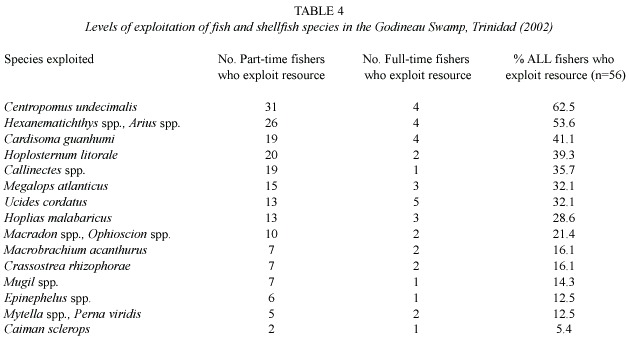
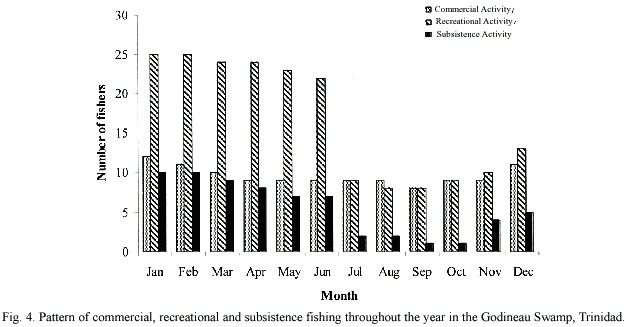
Economic and regulatory aspects of the fisheries
Currently,all forms of fishing are open access in the wetland.There are no bag limits,closed seasons or restrictions on species. No fees are charged for the use of the natural resource or any of the facilities.Recreational fishing activity did not usually involve high costs and were mainly group activities.Local commercial and subsistence fishers traversed the wetland on foot or used a boat to fish throughout the year.Fishers who used a boat (10 interviewed)had higher costs associated with their activity,which ranged from US$25 per day to US$1666 annually for boat maintenance and repair.Catches were sold at village markets (47.1%),house-to-house (41.2%),wholesale (35.3%)and at roadside stalls (29.4%).Registration with the Fisheries Division, (Ministry of Agriculture) is not required of inland fisheries in Trinidad, and consequently many of them do not benefit from state subsidies granted to registered fishers.There were no defined landing areas for wetland catches or fishing facilities with the exception of a single boating facility near the Grand Terre Picnic site.A very conservative estimate of the income earned from direct sale of the fish,shellfish and crabs from the swamp, derived from summing average earnings of the full-time fishers interviewed,was calculated at US$43 300 per annum.Fishing provides employment for a portion of the locals who have very limited options for viable livelihoods.
In this study,50%of the fishers interviewed had suggestions for regulatory mechanisms that would make fishing more viable in the swamp.Opinions came mainly from the commercial and subsistence fishers who had vested interest in the sustainability of the natural resources because of their long relationship with the wetland and because of their direct dependence on the continued availability of the resources.Some of the suggested mechanisms for improving the resource base included:
- Ban on fishing and crab catching to allow population recovery (8 respondents).
- More sustainable methods for fishing (6 respondents).
- Prevention of use of intensive fishing methods,such as commercial fishing and gillnetting (1 respondent).
- Habitat restoration,such as dredging and clearing blocked waterways to allow free passage with mangrove reforestation (5 respondents).
- Decrease pollution (5 respondents).
- Improve fishing /drainage infrastructure (4 respondents).
- Closed season (1 respondent).
Twelve (12)fishers surveyed offered that fishing with gillnets across the mouths of the main waterways of the wetland was a major factor in the decline in finfish catches.
Discussion
The wetland drainage had been modified since the early 1900s to facilitate oil exploration,later for agriculture and rice production (1920s –1980s),and more recently,for flood mitigation in the wet season.River channels have been cut and widened (the Forty Foot Trench and the New Cut Channel),levees have been built (the Trinidad Bank)and sluice gates have been installed (the Fourteen Gate Sluice, the St.John s Sluice and the Tulsa Trace Sluices) (Anonymous 1979).There have been oil spills in the wetland due to the corrosion of old inactive pipelines that still carry residual flow (Anonymous 2001)and pollution from past oil- related industrial processes (Rajkumar 2001).
Run-off from monoculture sugar-cane plantations may also have contributed to pollution affecting the habitats,the organisms that live in the area and the people that consume the organisms (Boodoosingh 1992).In spite of these conditions,the Godineau Swamp supports a productive system that has sustained all these uses as well as fisheries exploitation up to the present. The wetland still continues to be one of the major sources of organic matter,which supports the productive Oropuche Bank shrimp fishery in the Gulf of Paria (Kumarsingh et al.1996).
The major river systems are freshwater at the inland periphery of estuary for most of the year.During the wet season,the Gulf of Paria itself becomes estuarine (Anonymous 1999) with most of the wetland becoming freshwater to estuarine. During the dry season,salt water penetration up the main waterways causes most of the estuary to be estuarine.This has effects on the ichthyofauna in the wetland as organisms will live only in their tolerance range and if mobile,they move away from unsuitable areas.
Commercial fish species comprised only 18%of the total catch.It is possible that many of these species use the wetland for feeding,as a nursery and for shelter.It is also possible that many species were not captured in the sampling as the fauna collected was representative of only that portion of the communities vulnerable to the gear used (Nielsen and Johnson 1983).
Fish migrations caused by seasonal changes in the salinity are one of the factors that can account for differences in the populations sampled at the stations.The distribution of finfish species shows a high dominance by catfishes, especially a single species,Hexanematichthys bonillai .The relative abundance plots indicate that a dominance-pre-emptive model, which is characteristic of communities with low evenness and higher dominance,may best represent the distribution of the fish species.The implications of this are that niche space is very limited for most non-dominant species.
Field observations indicate that the wetland is used for spawning and as a nursery area for H.bonillai because of the large numbers of gravid females and brooding males captured,and possibly also a nursery area for Centropomus undecimalis as juveniles were found in the seine sampling.Plankton surveys or genetics-based research for confirmation that plankton larvae from the wetland were actually a source for recruitment for the Gulf of Paria fish stocks are subjects for further research.
Tropical island wetland fisheries are inevitably small-scale and target a wide range of species using different types of gear throughout the year.Recreational fishing may also compete with the commercial fishing in areas where it is practiced, especially in an open access environment.It may be beneficial for all fishers if a nominal fee is charged to support fishery management initiatives.The fishers themselves have expressed concerns that the resources may be in danger of severe depletion as catches have been decreasing while industrial development is replacing and destroying critical wildlife habitats.These concerns are not unique to this wetland,and feature commonly in the management of coastal zones (Clark 1992). Management of small-scale fisheries usually requires some innovation,as directives usually have to consider all the factors involved which may make the situations unique.The approach of formulating and implementing management directives should be consultative with the stakeholders and those responsible and affected by the directives,especially where scientific data may be lacking and traditional knowledge may add much to information regarding fisheries patterns and behaviour of species (Berkes et al.2001).
Regulations within the fishery are of little consequence if external factors,such as agriculture, drainage infrastructure,oil pollution, industrial and residential development that affect the integrity of the habitat and the fishery are not managed toward the same objective of maintaining a healthy wetland system.This can be achieved by screening all development and land use,proposed and existent,within the wetland and its watershed.Proposals should be reviewed through a consultative process with affected stakeholders.Public awareness and concern may put pressure on stakeholders to remediate habitats and implement pollution minimization procedures.Consideration of traditional rights, environmental impacts and mitigation of these impacts with a view to safeguard the rights of the stakeholders and the integrity of the wetland system should be the major factors in decision making for development and land use in and around the wetland area.This is in keeping with Trinidad and Tobago s national policy on wetlands of no net loss (National Wetlands Committee,unpublished).
As in many cases,however,where there is poor planning or lack of co-operation exists among stakeholders concerning management of public property and private interests,development of the coastal area is piece-meal and ad hoc ,usually leading to adverse environmental impacts (Clark 1992).Activities in the dry areas of the watershed affect the integrity of the wetland,so that conversion of the now abandoned agricultural land into residential areas (Ministry of Planning,pers comm.)will impact on the health of the already stressed wetland.
Conclusion
The abundance and distribution of wetland ichthyofauna in the Godineau Swamp is affected by ambient salinities and the ability of fish to access channels in the modified drainage system.There is a gradation in the diversity of the fish fauna communities,with the freshwater communities being more diverse and undergoing the most change during the dry to wet season transition.
Fishing in the wetland is a traditional activity supporting recreational,subsistence and commercial fisheries.There has been cause for much concern over the continued sustainability of the fish and shell-fish resources in the swamp because of impacts caused by over-exploitation of the resources,use of non-sustainable fishing methods,and existent and proposed land use for the area.
This study is a work in progress and has been done in conjunction with investigations on other aspects of the ecology and the socio-economics of the wetland and the population in the wider area to have a clearer understanding of the dynamics of the wetland system for the formulation of alternatives for wetland management.
This author recommends the following management measures.
- Public awareness programs to promote sustainable fishing methods and practices.
- Habitat restoration and rehabilitation of polluted areas of the wetland.
- Participatory integrated coastal zone management planning process in response to the multitude of stakeholder concerns and issues affecting the ichthyofauna and fisheries.
Recommendations from this study and those from other ecological and socio-economic evaluations of the wetland are to be considered to formulate and direct management of the wetland for the wise use and continued health of the system.
Acknowledgments
I acknowledge and express gratitude to the Gregory deSouza and Marisa Clarke-Marshall, staff of the Institute of Marine Affairs and Errol Caesar of the Tobago House of Assembly for assistance with provision of sampling gear and tedious hours of field work.
Resumen
El pantano Godineau (Oropuche Sur)(3171 ha)en la costa suroeste de Trinidad (10 º13-15 N,61 º30-32 W), sufre un impacto fuerte por actividades antropogénicas como pesca,exploración petrolera, drenaje y destrucción del humedal.Para reducir los efectos negativos de las actividades y dar un manejo sostenible,se necesita más información cuantitativa sobre la ecología de este lugar y las actividades que en él se llevan a cabo.Este estudio se enfoca en la distribución de los peces y de las pesquerías, como información base para el manejo.El muestreo fue realizado en el 2002,en abril y mayo (para la época seca) y de julio a septiembre (para la época lluviosa).Se muestreó ictiofauna de día y de noche con redes de trasmallo y redes de empuje (chinchorro).Las actividades pesqueras fueron cuantificadas utilizando un cuestionario y discusiones informales con los pescadores.El humedal mantiene más de 29 especies de peces distribuidas en ambientes de agua dulce,estuarinos y de agua salada (n=1454).La distribución de las especies es estacional,y hay evidencia de que el pantano es utilizado como área de desove.La riqueza de especies y la diversidad (índice de Shannon-Weiner)para el humedal,tienen un ámbito de 2-11 y 0.162-0.967,respectivamente,en la estación seca y de 2-7 y 0.036-0.903,respectivamente,en la estación lluviosa. Hexanematichthys bonillai fue la especie dominante en las comunidades que habitan zonas de agua salada y estuarinas del humedal.Los porcentajes del índice de similitud fueron del 41.8%para agua dulce,72.7%para estuarios y 79.8% para comunidades estuarinas-saladas.Las especies comerciales comprendieron el 18%de la captura total y constan de:Centropomus undecimalis,Megalops atlanticus, Hoplosternum littorale,Hoplias malabaricus,Ophioscion punctatissimus y Macrodon ancyclodon .Los pescadores de tiempo completo y tiempo parcial,incluyendo los pescadores recreativos,fueron el 14.3%y 85.7%respectivamente,de todos los pescadores encuestados (n=56).Una estimación conservadora de las ganancias por peces y otros mariscos,directamente en el punto de venta,es de aproximadamente US$43 000 por año.La pesca es importante en el área.Se necesitan directrices de manejo que tomen en cuenta la ecología de los organismos clave,para permitir estas prácticas pesqueras de una manera sostenible.
Palabras clave:Pesquería en humedales,ictiofauna de humedales,distribución estacional,pesquería en islas,pesquería de agua dulce en el Caribe.
References
Alleng, G.P.1997.Coastal wetlands in Trinidad and Tobago:Status and trends research report.Institute of Marine Affairs,Chaguaramas,Trinidad.59 p. [ Links ]
Anonymous.1979.Development of the Oropuche area-pre-feasibility study funded by the European Development Fund-Technical report including appendices and maps.SCET Agri International.Portof-Spain,Trinidad.164 p. [ Links ]
Anonymous.1999.Fourth progress report on the environmental monitoring program for the 6th sampling period of benthic,marine water and sediment quality and at the construction outfalls at the LNG production plant,Point Fortin,Trinidad.Institute of Marine Affairs (IMA).Document prepared for Atlantic LNG Company of Trinidad and Tobago.181 p. [ Links ]
Anonymous.2001.Report on the Investigation of an Oil Spill in the Oropuche River,South Oropuche Swamp, Trinidad. Environmental Incident Report.Institute of Marine Affairs (IMA),Trinidad.24 p. [ Links ]
Begon,M.,J.L.Harper &C.R.Townsend.1996.Ecology: Individuals,Populations and Communities,3rd Ed. Blackwell Science, London.1068 p. [ Links ]
Berkes,F.,R.Mahon,P.McConney,R.Pollnac &R.S. Pomeroy.2001.Managing small-scale fisheries: Alternative directions and methods.International Development Research Centre,Ottowa,Canada.320 p. [ Links ]
Boodoosingh,M.1992.A review of possible impacts of human activities on fisheries in the coastal waters of Trinidad,with emphasis on the Gulf of Paria. Fisheries Division,Ministry of Agriculture,Land and Marine Resources,Port-of-Spain,Trinidad.125 p. [ Links ]
Brower,J.E.,J.H.Zar &C.N von Ende.1990.Field and Laboratory Methods for General Ecology.3rd Ed. W.C.Brown Publ.,Dubuque,Iowa.237 p. [ Links ]
Clark,J.R.1992.Integrated management of coastal zone. FAO Fisheries Technical Paper 327. FAO,Rome, Italy.167 p. [ Links ]
Fischer,W.1978.FAO species identification sheets for fishery purposes:Western Central Atlantic (Fishing area 31),Vol.II.Food and Agriculture Organization, Rome,Italy. [ Links ]
Itakura,K.1974.The profile of rice and Oropuche Project. Ministry of Agriculture,Field Engineering, Trinidad and Tobago.47 p. [ Links ]
James,C.1990.Wetlands in Trinidad and Tobago.National report for Trinidad and Tobago.5 th Caribbean Foresters Conference May 22-25,1990,Port-of- Spain,Trinidad.35 p. [ Links ]
James,C.,N.Nathai-Gyan &G.Hislop.1986.Trinidad and Tobago,p.256-265.In D.A.Scott &M.Carbonell (eds.).A Directory of Neotropical Wetlands:IUCN Concerv.Monitoring Centre,Cambridge,UK. [ Links ]
Kumarsingh K.,L.A.Hall &A.M.Siung-Chang.1996.Spatial and temporal variations of particulate and sediment organic matter on a shallow,tropical,estuarine bank off Trinidad,West Indies.Carib.Mar.Stud.44:1-13. [ Links ]
Neilsen,L.A.&D.L.Johnson (eds.).1983.Fisheries Techniques.South.Print.Comp.,Virginia.468 p. [ Links ]
Rajkumar,G.2001.A natural resource damage assessment of a contaminated site in the Godineau Swamp, Trinidad.M.Sc.Thesis,Univ.West Indies,Cave Hill, Barbados.84 p. [ Links ]
Rakocinski,C.F.,B.H.Comyns,M.S.Peterson &G.A. Zapfe.2000.Field growth responses of juvenile white trout (Cynoscion arenarius )to continuous variation in physical habitat conditions.53rd Ann. Gulf Carib.Fish.Inst.,Biloxi,Mississippi.13 p. [ Links ]
Ramcharan,E.K.,G.deSouza &R.French.1982.Technical report:Inventory of the living resources of coastal wetlands in Trinidad.Institute of Marine Affairs, Chaguaramas,Trinidad.212 p. [ Links ]
Ramnarine,I.W.1997.Report on the fisheries ecology of the Caroni swamp.Consultants Report to the Inter American Development Bank,Port-of-Spain, Trinidad.74 p. [ Links ]
Internet reference
Thurston,R.V.&P.C.Gehrke.1992.OXYREF (Oxygen Requirements for Fish)a datafile of test results reported in the literature on the respiratory oxygen requirements of fishes.Montana State University,Montana. (Downloaded:October 25, 2004, http://www.epa.gov/ceampubl/swater/oxyref/USERMANU.PDF). [ Links ]













